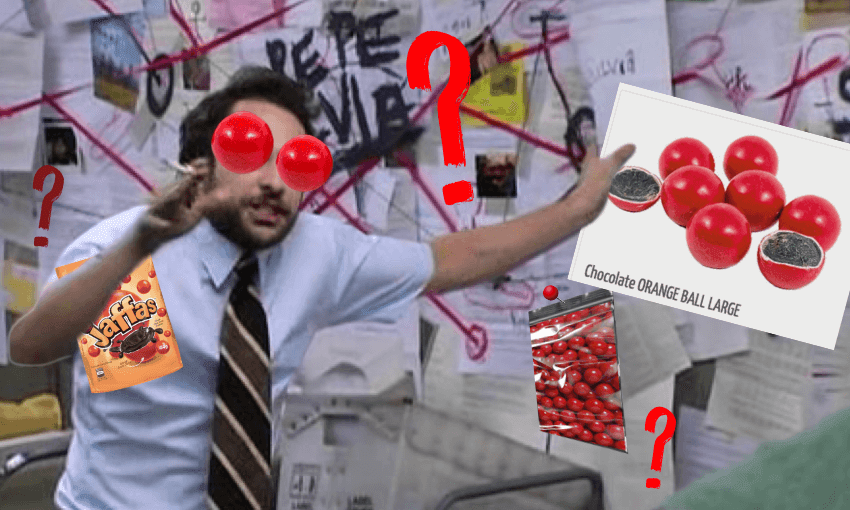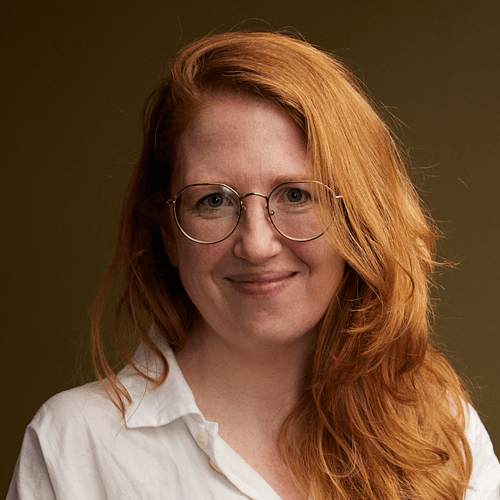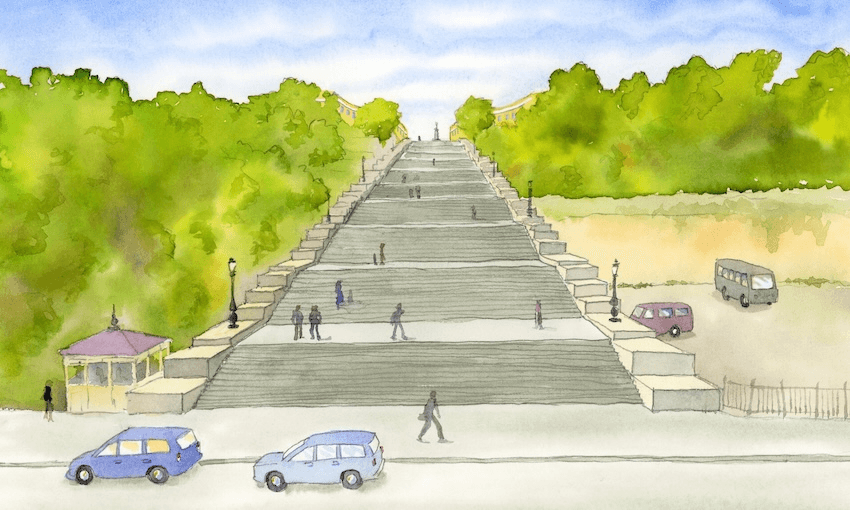Claire Mabey uncovers a giant Jaffas conspiracy.
“You don’t know what you’ve got til it’s gone.” – Joni Mitchell in a song that was later covered by Counting Crows.
“You don’t know what you’ve got til you realise you never had it.” – Claire Mabey
Content warning: What I am about to tell you will change everything you think you know. Please continue with care.
They’re small and round and tinged with citrus. They’re like marbles, only opaque, and not made of glass. Some people bite right into them like the cave men before us while others prefer to suck them slowly until the outer shell is compromised and eventually melts away to reveal the chocolate orange centre which also melts and becomes a tiny hot chocolate made with your own spit.
I, like many New Zealanders, like to indulge in a Jaffa at the movies. It’s a reliable, comfortable habit in a reliable, comfortable place. There’s the popcorn, and the Jaffas, and the pineapple lumps and there’s the previews and the dark room and the giant screen. In fact that’s the only place I have ever eaten Jaffas other than the odd one offered up for free with a long black – a lovely little gesture that felt like something that was just ours. A solitary treat-Jaffa given by the kind of cafe you could take your nana to.
When I heard that RJ’s was going to stop making Jaffas I discovered I was upset (though it was nothing compared to when Pascall stopped making Snifters). Isn’t there enough change in this world? Aren’t we losing so much already? The climate? Species? Why take away our movie treats too?
This question weighed heavy on my mind when I went to my local cinema, purchased my ticket to Jurassic Park: Rebirth, and a small white bag of Jaffas. As ScarJo and Jonathan Bailey dodged the grotesque mutant dinosaur and told each other that 99.9% of species are now extinct, I took comfort in sucking approximately 12 Jaffas so slowly they lasted almost the whole film.
When the film was over I shuffled out of the dark cocoon and into the light with my empty little white paper bag in my hand (screwed up and sweaty thanks to the dinosaurs). I walked it to the rubbish bin closest to the counter and said to the cinema worker who was tidying up some empty water glasses: “It’ll be weird not to have Jaffas soon, eh?”
The young woman stared at me with a quizzical look. I’d said something wrong. “You know, Jaffas?” I said and pointed to the row of plump little white paper bags filled with Jaffas in front of her on the counter. RJ’s Jaffas in little white paper bags.
“Oh, yeah well actually we use Choc Orange Balls.”
Silence as I stared back, my heart giving odd little skips. “What are those?”
“Choc Orange Balls? You can get them from Moore Wilson’s.”
Choc Orange Balls? I stared at the bin. At the sad little paper bag lying there. All this time? I’ve been eating “Choc Orange Balls”? Have they always been Choc Orange Balls? Have I ever eaten an actual Jaffa? An actual RJ’s Jaffa?
Have any of us?
I was shaken. Had I just inadvertently uncovered a massive conspiracy? Or was I simply the last one to know that there are off-brand Jaffas out there in the world masquerading as actual Jaffas? Determined to uncover the truth I pulled on my coat, pushed my way through the crowd and out onto the cold Wellington street. Everything looked different. Shop fronts, street signs … the air itself felt … colder. I took my usual shortcut through the carpark and down the side street to where Moore Wilson’s sat smugly like Wellington’s most Wellingtonian home of fresh produce and fancy breads and Ottolenghi products and freshly squeezed orange juice that people will literally line up for 30mins to get on a Saturday and that you can’t get at all when there’s flooding in Tairāwhiti.
I knew I’d never seen Jaffas at Moore Wilson’s before. At least not on the produce side. But what about the bulk purchases side? That’s where I once bought a carton of Spacemen and a massive tube of 100 Chuppa Chups. Could that be where these “Choc Orange Balls” lived? I held my breath as I slipped past the lanes of checkout workers and past the boxes of generically packaged lollies to the tall shelves where the branded bulk lollies were arranged.
And there they were. Bold as brass. A huge box of red and brown bags with a small Moore Wilson’s product sign below them: “Confectionery House Chocolate Orange Balls 1kg. $24.70 / Ea.”
The lady at the movies was telling the truth. Here they were right in front of me. Choc Orange Balls. I picked up a bag and inspected the contents through the window of clear packaging. Small, orange balls. Like marbles but opaque. I flipped the bag over and read and as I did my world came crashing down. “Handmade by our artisan confectioners right here in Australia.”
Oh. My. GOD. Australians. They hadn’t even tried to give them a cool name. Just Choc Orange Balls. Like something out of South Park.
As I stood there in front of a wall of lollies in Moore Wilson’s, a bag of Choc Orange Balls heavy in my arms, I asked myself how long this had been going on? Who else was slipping into Moore Wilson’s to buy pretend Jaffas in bulk and hawking them as the real deal?
Maybe this was a one-off. Maybe this cinema just didn’t even really know? Maybe there was an Australian in charge with Australian tastes?
I grabbed a bag, paid $24.75 for it and got the number 29 home. Wellington has many cinemas. They’re part of what makes our city great. When it’s windy and shit you go to the movies and you eat Jaffas, real Jaffas, and chew them up with your popcorn so you get sweet-savoury at the same time.
I got out my coloured post-its and wrote down the names of all the cinemas I could remember and stuck them on the wall in my office. One by one I phoned them.
“Hi, do you sell Jaffas?”
“Oh pretty sure we sell an off-brand Jaffa,” the guy on the other side said, and laughed.
WHAT.
“So, like, what do you sell?”
“Hold on, I’ll just go check.”
My heart was pounding, my pits were oozing, and I was shovelling Choc Orange Balls while I waited like they’re the ones going out of fashion.
“You there?”
“Yup.”
“We sell Choc Orange Balls.”
“Do you put them in little white paper bags?”
“Yes.”
“What do you call them?”
“Ah. Um … why do you ask?”
“Do you call them Jaffas?”
Suddenly he was suspicious. He knew I was investigating.
“Why are you asking?”
I slammed the phone down. I pulled the post-it with the name of that cinema off my wall and screwed it up and tossed it into the bin just like that little white paper bag that had never seen a Jaffa.
I called up the next cinema, trying to keep calm while my mind raced.
“Hi, do you sell Jaffas?”
“Yep.”
“RJ’s Jaffas that are Jaffas? Or do you sell something else?”
“We get Choc Orange Balls from Dandy Candy in Petone.”
Dandy Candy?
“What’s Dandy Candy?”
“A distributor.”
“Thanks,” I said, scribbling it down. “And before I let you go can I just ask if you sell your Choc Orange Balls in little white paper bags?”
“Yes we do.”
God damn it.
I put the phone down and stared at my notes. Dandy? Candy? It sounded like an off brand version of that terrifying Candyland board game where the gingerbread man has to run through lolly streets to escape certain death.
I turned to Google. “Dandy Candy NZ lollies distributor”. And there it was. Not Dandy but Dandi. Of course.
There were rows and rows of branded treats: Cadbury, Pascall, The Natural Confectionery Company. I gingerly clicked into the search bar and typed, “Choc Orange Balls”.
An image of bright red-orange balls burst onto my screen. Not even any packaging, just naked balls spilling everywhere, some broken into rubble with their innards exposed like they’d been chewed and callously spat out.
It was true. Everything the cinema people had told me was true.
At the top of the screen was a phone number. Just a cell number, not even an 0800. Who knows where this string of digits would lead me next. I took a deep breath, dialled it and waited with my heart hammering in my ears.
Ilesh Patel answered and what I didn’t know then was that this conversation would fundamentally change me as a person. What Patel told would transform my understanding of how lollies worked in this country; in this world.
DandiCandy is a family-owned and run licensed candy wholesaler that has been operating in the Wellington region for nearly 25 years. Patel has 480 customers including supermarkets, dairies, Air New Zealand, Kiwi Rail, and yes, cinemas. And Patel distributes 30 brands including RJ’s and its Jaffas.
“It’s a big loss,” he told me, “but there’s always someone bringing in something else.”
“Like the Choc Orange Ball?” I asked.
Patel confirmed that they sell a lot of Choc Orange Balls but what he told me next blew my mind and made the decimated Choc Orange Ball now acidifying in my belly start to riot.
“The difference between Choc Orange Balls and Jaffas is that Choc Orange Balls are made out of compound chocolate.”
What in the fresh hell??
I flipped over the Choc Orange Balls packet in front of me and read the ingredients list: “Compound Dark Chocolate” was the first item. It’s not even buried – it’s just right there.
God Damn It! Is this like the friends episode where Monica has to make recipes out of Mocklit? I put Patel on speaker and frantically googled. “Compound chocolate is a product made from a combination of cocoa, vegetable fat and sweeteners. It is used as a lower-cost alternative to pure chocolate (“whole chocolate” is natural raw chocolate that contains cocoa butter) as it has less-expensive hard vegetable fats such as coconut oil or palm kernel oil in place of the more expensive cocoa butter,” says Wikipedia.
“So it’s not even real chocolate?” I asked.
No, he said. No it’s not.
What Patel explained to me next I can only relay in fragments and I’m sorry about it but I was reeling. I felt sick from all the compound chocolate in the Choc Orange Balls. But what he told me was that in essence we are just too small to sustain the Jaffa, or the Snifter, or the solitary packaged Chocolate Fish, or the god damn Toffee Milk! (I cried out as a core memory of buying five Toffee Milks for 50 cents from my local dairy shunted forth and stabbed me with its nostalgia.) Australian companies like The Confectionery House are just too big. They’re too powerful and what they dictate, we have to follow.
Patel then told me that RJ’s was sold to an Australian company in 2015 and what could be going on is actually it’s the Australian parent company that doesn’t want the Jaffa and we’re just too small to …
WHAT? I put my head in my hands (Patel was still on speaker). Not. Even. Locally. Owned? RJ’s is Australian? What ISN’T Australian? When is this going to stop? When are they going to stop? God damn it!
“Are you there?”
I apologised to Patel and explained I just needed a second to compute the enormity of what he’d told me. He asked me then if I remembered the giant Jaffa.
And I don’t. I don’t remember it because maybe it was too brief. Or maybe there never really was a giant Jaffa, just a giant Choc Orange Ball sold in a white paper bag.
Have I ever even eaten an actual Jaffa with its real chocolate and expensive fat? Will Australia ever stop taking stuff we really like even if we don’t actually buy it that often?
All I know is that I have been eating Choc Orange Balls for a long time. I think a lot of us have been eating Choc Orange Balls for a long time.
“That’s so much for your time, Ilesh,” I say. I put my phone down and stare at the packet in front of me. I glance up at my post-it wall. There is one cinema left. I pick up my phone once more, unsure if I am emotionally ready for whatever might come next, and dial the number.
“Hi, do you sell Jaffas?”
“Yes! Jaffas are the bomb!”
I’m wary. “OK, but are they RJ’s Jaffas called Jaffas by RJ’s?”
“Yes! I’m going to really miss them. I love them.”
Bless you, angel.
“When they’re gone, will you go for an alternative, like… the Choc Orange Ball, have you heard of those?”
“No, but we probably won’t replace them.”
“Why not? Don’t people buy Jaffas?”
“Nah, not really. They just get M&Ms.”






